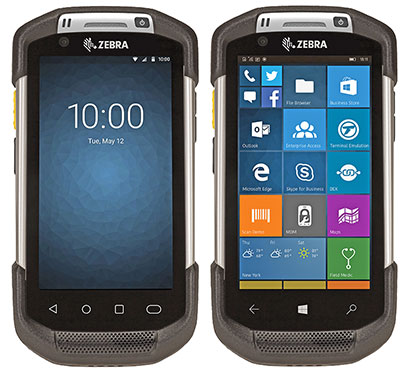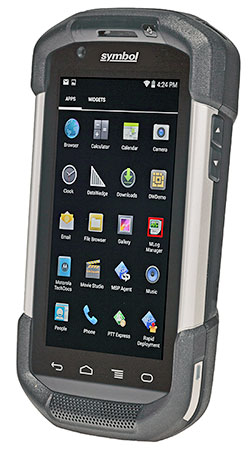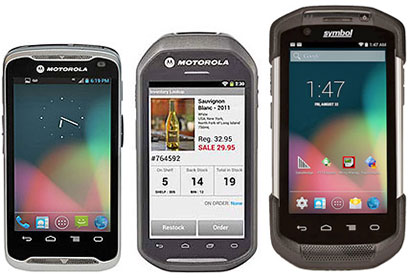As of late 2016, Zebra expanded the TC70 Series of ultra-rugged touch computers with the TC70x. The new model is available with either Android 6.0 "Marshmallow" or Windows 10 IoT Mobile Enterprise. The original Android-only TC70, first introduced October 2014, remains available.

As was to be expected, the enterprise division of Motorola Solutions, which is now part of Zebra, was early to the Android for the enterprise party. As early as October 2012, they announced that three of their popular enterprise mobile computers would be available with Android,  fortified with Motorola's own Mx security, device management and performance features that they added to the standard Android OS. Early 2014, that trio was joined by the sleek and smartphone-like TC55 "touch computer," and in October 2014 by the TC70, similar to the TC55, but a bit larger and a lot tougher.
fortified with Motorola's own Mx security, device management and performance features that they added to the standard Android OS. Early 2014, that trio was joined by the sleek and smartphone-like TC55 "touch computer," and in October 2014 by the TC70, similar to the TC55, but a bit larger and a lot tougher.
In essence, while the TC55 sought to provide something as sleek and easy to use as workers' own personal smartphones, but with business-class durability and security, the TC70 does all that, but in an updated package with extra features and the ability to absorb a lot more punishment.
Below you can see the three enterprise Android handhelds. On the left is the TC55 that was launched February 2014, in the middle the MC40, introduced early 2013, and on the right the TC70. The new device is the most powerful, and the one closest to contemporary smartphone state-of-the-art. Motorola Solutions knew that giving people the same technology at work that they already use away from work is a good idea. But it must be in a package that fits right into the enterprise.

So what's new and different with the TC70, especially compared to the TC55? At first sight we thought the TC70 was really just a TC55 in an exo-suit for more protection. But while there's a significant familiy resemblance, there are also substantial differences. The T70's display, for example, measures 4.7 inches diagonally and sports super-crisp 1280 x 720 pixel resolution whereas the TC55 has a 4.3-inch 800 x 480 display. Since one of the goals of this class of handheld is to provide the kind of consumer smartphone technology people are already used to, the move to a larger display makes perfect sense.
On the technology side, there's a Qualcomm Snapdragon 8060 1.7GHz dual-core processor. There's 8GB of Flash, complemented by up to 32GB via externally accessible micro-SD card.
Unlike the TC55 that used its camera for scanning, the TC70 has an industrial grade SE4750 1D/2D imager.  This little marvel represents a new generation of imagers that provide superior performance on just about any type of data imaginable, from 1D and 2D bar codes to photos and fully searchable and editable legal, letter, A4 and A5 documents. The SE4750 has laser aiming, can be used in direct sunlight, and, depending on the size of the code, can scan from up to three feet away.
This little marvel represents a new generation of imagers that provide superior performance on just about any type of data imaginable, from 1D and 2D bar codes to photos and fully searchable and editable legal, letter, A4 and A5 documents. The SE4750 has laser aiming, can be used in direct sunlight, and, depending on the size of the code, can scan from up to three feet away.
The TC70 is an Android device and uses Android AOSP version 4.4.2, part of the "KitKat" generation of the OS. AOSP stands for Android Open Source Project, and is an open-source software stack and project led by Google itself, but without the ability to use the Google Play store and some of the major Google apps. And the Android implementation used in the TC70 is fortified with Zebra's own Mx security, device management and performance features that they added to the standard Android OS. The device also retains backward compatibility with existing warehouse management systems and telnet apps via Zebra's platform-independent RhoMobile Suite if the apps have been written using those developer tools (see product page).
Android is totally geared towards touch, and so the TC70 uses capacitive multi-touch with some extras baked in. First, this multi-touch can be used with even thick gloves. Second, it's really a "dual mode" touch system as it can also be used with a narrow-tip conductive stylus for signature capture and such. And third, the system is largely auto-sensing, so there's no need to change software settings when switching from finter touch to using the stylus.
On the connectivity and communications side, there's dual-band 802.11a/b/g/n WiFi, NFC and Bluetooth 4.0, but no mobile broadband as this is not conventional phone. There is a speaker with up to 108 dB volume though (which is about four times as loud as the loudest consumer phone), and not one but three microphones for maximum voice clarity, and since there's also a front camera in addition to the rear documentation camera, users can make WiFi calls even with video. The company stresses the ongoing importance of voice communication, and so the TC70 includes WorkForce Connect Push-To-Talk (see expalantion).
The device supports USB host and client, and charging is via an included rugged charging cable with high-impact contacts rather that provide a robust alternative to the more fragile micro USB connector.
With its hefty protection, the TC70 is considerably larger and heavier than the sleek TC55. Its footprint is just a tad larger than the iPhone 6+, but the TC70 is a hefty 1.1 inches thick and it weighs 13.3 ounces. In return for the thickess and weight users not only get that industrial-grade scanner, but also remarkable ruggedness. There's IP67 sealing, which means it can survive a dunk in a puddle. It can also handle 6-foot drops to concrete, and the device was subjected it to all sorts of MIL-STD-810G torture tests, including tumble (2,000 from a height of 3.3 feet!), vibration, thermal shock, humidity, etc. The operating temperature range is -4 to 122 degrees Fahrenheit, good enough for use virtually anywhere. And the screen is protected by Corning's incomparable Gorilla Glass 2.
All of this looks a timely addition to Motorola Solution's lineup. Or Symbol's lineup, rather. With Zebra Technologies' impending acquisition of Motorola Solution, the Symbol name has returned and Moto Solutions will once again be known as Symbol. Any which way, judging by the specs, the TC70 may well be the overall toughest advanced Android-based handheld available today.
Below is the introduction video of the Symbol TC70:



